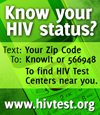Conversation with Ronald Valdiserri, U.S. Department of Veterans Affairs
Transcript
September 14, 2007
Ira Dreyfuss: AIDS.gov welcomes you to "Conversations on AIDS.gov".
Today we are speaking with Dr. Ronald Valdiserri from the U.S. Department of Veterans Affairs. Dr. Valdiserri, welcome and thank you for joining us today.
Dr. Valdiserri: Thank you, Ira.
Ira Dreyfuss: What is your role at the VA?
Dr. Valdiserri: I’m in charge of the Public Health Strategic Healthcare Group at the Department of Veterans Affairs Health Administration, and that’s the group responsible for developing programs and policies to promote early diagnosis of HIV infection for America’s veterans, as well as prompt referral into treatment and care for veterans who are found to be infected with HIV.
Ira Dreyfuss: Would you please describe the needs of veterans living with HIV/AIDS?
Dr. Valdiserri: Most Americans don’t realize that the Department of Veterans Affairs is the single largest provider of HIV care in the United States. We have over 22,000 HIV-infected veterans that we’re caring for in our system.
Now, our population is predominantly male, as you might guess, but we do have several hundred female veterans who are being treated for HIV infection. Our veterans living with HIV/AIDS, most of them are in the forty to sixty-year-old age range. So they do have issues that we see in older populations—whether those are the onset of cardiovascular disease, metabolic abnormalities. This is a very important dimension of their care.
We also do have a proportion of our infected veterans who are homeless. And so we have to develop a special means of outreach to provide them with the kind of care they need, so that we can diagnose them in a timely manner and certainly get them referred into care.
And finally, I would say that we have, on estimate, probably about a third of our HIV-infected veterans are also infected with Hepatitis C virus. And so that raises some special concerns about coordinating the care for their Hepatitis C virus as well.
Ira Dreyfuss: How can people find out more about the VA’s HIV/AIDS programs?
Dr. Valdiserri: The VA has a website at HIV.va.gov, which is very user-friendly. There are two portals—one directed primarily towards patients and the public, and another one for healthcare providers that contains more technical information related to diagnosis and treatment of HIV disease. And I think it’s very useful to visit this site because it reminds providers in the private sector, and also leadership in the public sector, that the VA is a very important resource when it comes to providing care for HIV-infected persons.
Ira Dreyfuss: What actions would you like to see public health officials take or continue to take to address the needs?
Dr. Valdiserri: Certainly in terms of veteran patients, we would like to see leadership continue to stress the importance of early diagnosis of HIV infection. Like other healthcare systems in the United States, we too have a problem with late diagnosis of HIV infection.
Certainly we want to continue to see leadership support systems that can provide ongoing prevention information for veterans who are living with HIV, as well as ongoing clinical preventive services for patients who are living with HIV. Many of these individuals will develop other medical conditions, either related to HIV or the treatment of HIV, or, aging as the population becomes older. So it’s very important that we continue to support systems that can provide holistic care for all of the healthcare needs of veterans who are living with HIV.
Ira Dreyfuss: Thank you for speaking with us today about the important work the VA is doing to help meet the needs of veterans living with HIV/AIDS. For more information on the VA, go to va.gov.



